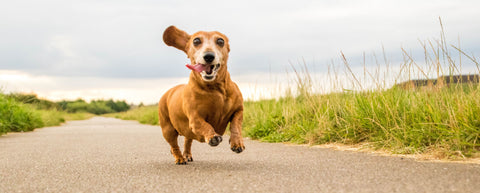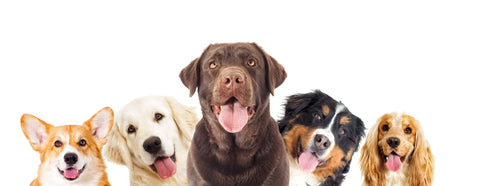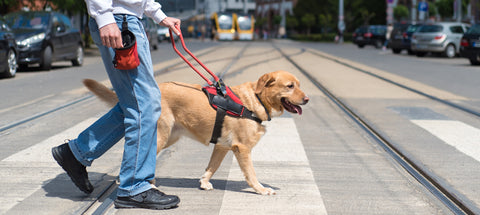Here at YuMOVE, we’re firm believers in looking at the bigger picture to help our dogs feel healthier and happier. And now lighter nights are just around the corner, we’re taking time out to spring clean our routines! From brushing up on the healthcare basics to detoxing our dogs' diets and considering the benefits of supplements, it’s all here…
Winter can see us swap long walks with our dogs for a quick game of fetch before retreating for a cuddle on the couch. But now sunnier spring days are on their way, we thought it might be time to put together a checklist to follow for a happy, healthy 2020.
Start with a health check up
The first place to start when it comes to happy, healthy dogs is your veterinarian. Though it may not lead to happily wagging tails on the day, a check-up is the best way to make sure your furry friend is in great health.
Because our dogs can’t talk to us, veterinary expertise is essential when it comes to spotting – and treating – issues. To make the most of your check up, it’s worth having a think about what’s been happening in your dog's life and being prepared with questions about changes in their behaviour:
- How is their appetite, have they been eating or drinking more or less than usual?
- Have they been slowing down on walks?
- How is their skin and coat condition?
- Are they as eager as they’ve always been to play and exercise?
- Has their behaviour changed?
- Has their weight changed?
Monthly at-home health checks
At YuMOVE we’re big fans of the at-home health check, too. Our veterinary nurse has put together an easy checklist for you to run through once a month:
- Run your hands over your dog's whole body to check for lumps, bumps or sore spots – pay particular attention to ‘underarms’, inner thighs, tummy, and around the neck.
- Check nail length
- Look between the toes and pads for signs of sore skin or wounds caused by grass seeds.
- Pay attention to ears – a weekly clean with an antibacterial ear cleaner can help to avoid infections and wax build up.
- Check teeth and breath – it’s a good idea to clean dog teeth every day, but if your dog won’t play along, aim for a monthly clean and check up at least.
- Re-apply tick and flea protection – depending on the recommendation of the product you use.
- Consider a weigh-in – if your dog is prone to putting on weight, keep track with a monthly scale session.
Top tip: The easiest way to weigh a reluctant dog at home is to weigh yourself, then pick up your dog to take a second measurement. Now simply subtract your weight from the second total to deduce your cat or dog’s weight. Not recommended if your furry friend is a Great Dane!
‘Detox’ your dog's diet
Unfortunately, some popular dog foods contain lots of surprising ingredients – things like food colouring, flavourings and unhealthy cereals – so it’s worth checking what you’re putting in your best friend’s bowl.
What’s more as time passes, manufacturers can change their recipes and formulas, and your dog’s needs can change. So even if you’re really confident in the quality of your dog's food, it’s worth sense checking every now and again.
Things to think about
- Is your dog getting the nutrition they need for their life stage – growing, adult and older dogs all need a different balance of nutrients.
- Are they getting the right protein and energy mix for their level of exercise and lifestyle?
- Do they have any specific concerns – cat and dog supplements can provide great support for active and aging joints, delicate tummies, skin and coat, even help with calming.
- Does your dog have a medical conditions that could be supported by a change of diet? There are great low-calorie, filling foods available for dogs who need to lose weight for example.
- If you feed raw or homemade food, is your dog's diet complete and balanced?
Last but not least, when it comes to diet, we humans sometimes struggle to get the balance right (hello cookie jar, my dear friend!) – and the same can apply to our dogs. Treats can be surprisingly high in calories, so be mindful of how little extras can result in weight gain over time.
Our top tips for healthier eating and treating include:
- Slice up some fresh carrots and other veggies like green beans, peas, celery and cucumbers (skip the onions because they’re toxic for dogs).
- Try feeding your dog half a banana, apple or pear instead of part of your steak or fries.
- Toss some blueberries in a bowl – a superfood rich in antioxidants.
- Chop up some cantaloupe.
- Reduce your dog's kibble by about 10 or 20 pieces. You’ll be helping them keep trim and they won’t notice the difference.
Fitness is always so much more fun with a friend – and appropriate exercise is essential for a happy, healthy dog. And if you’ve let your own exercise routine get a little lax over the colder months, now’s the time to start getting into shape together.
5K with Fido?
Depending on your dog’s age, health and breed, a fitness challenge can be a brilliant way to turn walks into a personal challenge. If your dog is relatively fit, well trained, and has no health problems, why not try a couch-to-5-mille running app? Most dogs love to run and get super-excited when their ‘running kit’ comes out… which helps to keep you motivated and on track too.
Before starting to run together, consider:
- Visiting your vet to check that everything’s OK health-wise.
- Investing in a safe, well-fitted harness and shock-absorbing lead.
- Training somewhere safe for your dog – park runs are easier on joints and pads than pounding the pavement.
- Get some reflective gear – and a bright coloured or reflective lead or lightweight high-viz coat for your dog.
- Supporting active joints with an appropriate supplement, like YuMOVE Active Dog.
If you find you love to exercise together, the next step could be USDAA Agility as a fun and challenging activity to do together.
More doggie sports
If running’s not your thing, there are lots of ways to have fun and get fit with your dog. As well as enjoying walks in new places, why not try a beginner’s agility or flyball session, or give obedience or doggie dancing (canine freestyle) training a try? You’ll both have lots of fun, whilst burning a surprising number of calories.
Have you started a keep fit plan with your dog? Is your dog or cat on a diet – and how are they getting on? Maybe you’d like some advice or to share some top tips?
Please leave a comment on our Facebook and Instagram pages and tell us how your spring routine clean-up is going – we always love to hear from you.










